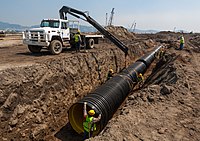
Photo from wikipedia
Abstract Use of agricultural subsurface drainage systems in the Prairie Pothole Region of North America continues to increase, prompting concerns over potential negative effects to the Region's vital wetlands. The… Click to show full abstract
Abstract Use of agricultural subsurface drainage systems in the Prairie Pothole Region of North America continues to increase, prompting concerns over potential negative effects to the Region's vital wetlands. The U.S. Fish and Wildlife Service protects a large number of wetlands through conservation easements that often utilize standard lateral setback distances to provide buffers between wetlands and drainage systems. Because of a lack of information pertaining to the efficacy of these setback distances for protecting wetlands, information is required to support the decision making for placement of subsurface drainage systems adjacent to wetlands. We used qualitative graphical analyses and data comparisons to identify characteristics of subsurface drainage systems and wetland catchments that could be considered when assessing setback distances. We also compared setback distances with catchment slope lengths to determine if they typically exclude drainage systems from the catchment. We demonstrated that ...
Journal Title: Journal of Fish and Wildlife Management
Year Published: 2018
Link to full text (if available)
Share on Social Media: Sign Up to like & get
recommendations!